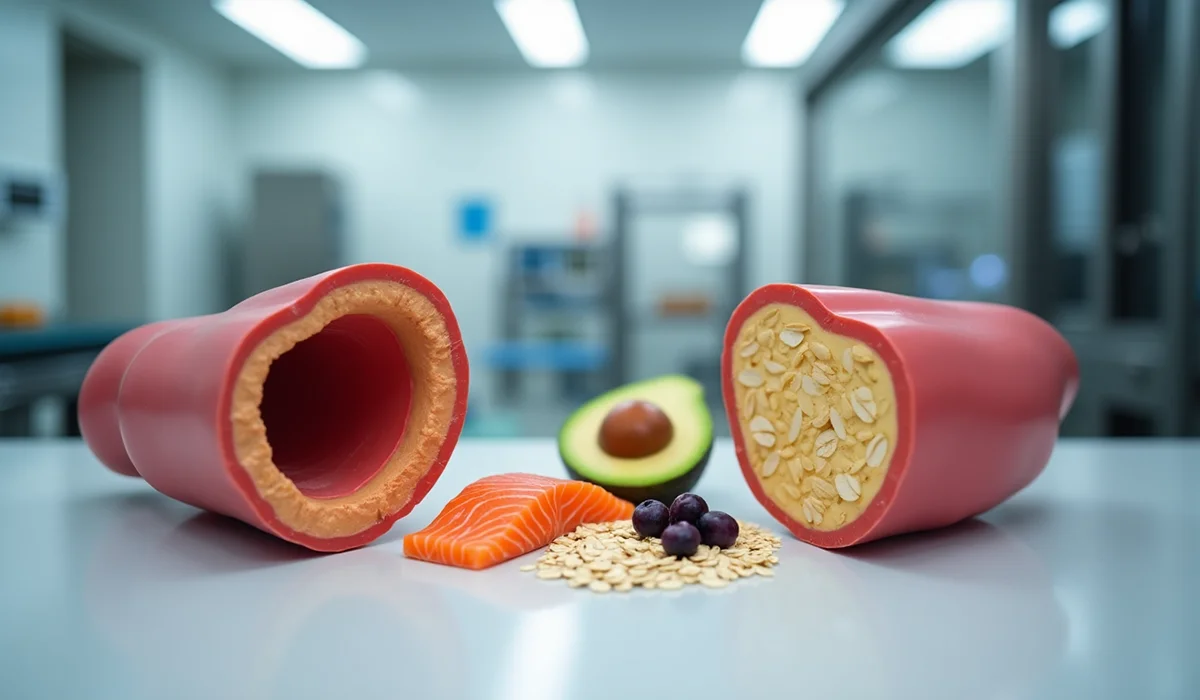The relationship between hormones and cholesterol goes much deeper than most people think. Our bodies are amazing – they make about 80% of the cholesterol we need through our liver and intestines. Diet accounts for just 20%. But what exactly are hormones, and what do they do in the human body?
Hormones are chemical messengers produced by the endocrine system, playing a crucial role in regulating various bodily functions. Our body’s cholesterol forms the building blocks for all steroid hormones, including estrogen, progesterone, and testosterone. These hormones in the body are essential for processes like metabolism, reproduction, and blood sugar regulation. On top of that, our cholesterol levels don’t stay the same – they change by a lot based on our hormonal state. A woman’s cholesterol levels can swing up to 19% during her menstrual cycle as her estrogen levels shift.
In this piece, we’ll look at how our bodies turn cholesterol into vital hormones and why the liver produces it. You’ll also learn about the intriguing connection between estrogen and cholesterol levels, and how this key substance helps maintain our hormonal balance and health. We’ll explore the endocrine system function and its major role in hormone production, providing insights into how hormones work and where they are produced.
The Body’s Cholesterol Factory
Our body’s liver acts as a cholesterol factory that produces about 80% of the total cholesterol we need for daily functions [1]. This remarkable organ makes 700-900 mg of cholesterol each day through a complex process called cholesterologenesis [2]. The liver, along with other endocrine glands, plays a crucial role in hormone production and regulation.
Cholesterol synthesis happens through an intricate series of nearly 30 enzymatic reactions inside our liver cells [3]. We started with a simple molecule called acetyl-CoA that changes multiple times in both the cytoplasm and endoplasmic reticulum [4]. The synthesis follows four distinct stages: mevalonate formation, production of specific compounds called isopentenyl pyrophosphate, squalene synthesis, and the final conversion to cholesterol [2].
The liver keeps tight control over production through an elegant feedback system. The liver automatically reduces production at the time cellular cholesterol levels climb above 5% of total cell lipids [3]. A protein called SREBP2 handles this regulation and acts like a molecular switch that turns cholesterol production on or off based on what the cell needs [2].
All the same, the newly made cholesterol doesn’t just sit there. The liver blends this vital molecule with proteins to create special carriers called lipoproteins [5]. These carriers transport cholesterol throughout the body and make sure each cell gets the amount it needs for hormone production and other key functions [6]. This process is essential for the endocrine system to function properly and produce the necessary hormones.
From Cholesterol to Hormones: The Endocrine System at Work
The process of transforming cholesterol into hormones starts with a vital step in the mitochondria. We discovered that a specialized enzyme complex called P450scc (CYP11A1) converts cholesterol into pregnenolone through three distinct chemical reactions [7]. This conversion is the foundation of all steroid hormone production and limits its rate [8].
Pregnenolone then goes through several changes in both the endoplasmic reticulum and mitochondria [9]. The tissue type and its unique enzyme complement determine which specific hormone gets produced. The endocrine system, a network of glands that produce and secrete hormones, is responsible for this process. Here’s a list of endocrine glands and their hormones, showcasing some examples of hormones produced through this process:
- Adrenal glands: Cortisol – produced in adrenal cortex cells through P450c17 and P450c21 enzymes [9]
- Testes: Testosterone – combined in testicular cells via Delta-4 and Delta-5 pathways [9]
- Adrenal glands: Aldosterone – created through aldosterone synthase enzyme action [9]
- Ovaries: Estrogen – formed through P450aro enzyme in ovarian cells [7]
- Pancreas: Insulin and glucagon – regulate blood sugar levels
- Thyroid gland: Thyroxine – influences metabolism
- Pituitary gland: Growth hormone, thyroid-stimulating hormone, and follicle-stimulating hormone
- Pineal gland: Melatonin – regulates sleep-wake cycles
The body’s hormone production process needs precise regulation mechanisms. The adrenocorticotropic hormone (ACTH) controls cortisol production, while luteinizing hormone (LH) regulates testosterone synthesis [8]. The cell’s peptide hormone receptor, its response to hormone stimulation, and its genetic expression of steroidogenic enzymes determine the type of hormone produced [9].
The steroidogenic acute regulatory protein’s (StAR) role is significant because it helps move cholesterol from the outer to inner mitochondrial membrane [10]. This protein’s action makes rapid hormone production possible within minutes of stimulation [10]. StAR protein mutations can lead to serious disorders in hormone production [10].
Hormonal Symphony: The Endocrine System in Action
Steroid hormones come from cholesterol and belong to five distinct classes that coordinate various bodily functions:
- Progestins – Active in pregnancy
- Glucocorticoids – Promote glucose synthesis
- Mineralocorticoids – Regulate ion balance
- Estrogens – Control female characteristics
- Androgens – Manage male characteristics
These hormones use only a small portion of the body’s total cholesterol [11], yet they significantly affect physiological functions. The adrenal cortex, ovaries, testes, and placenta keep tight control over hormone production [8]. The endocrine system, including the hypothalamus and pituitary gland, plays a crucial role in orchestrating this hormonal symphony.
The body uses several sources to meet its cholesterol needs for hormone synthesis. Cells can create cholesterol directly from acetate, get it through plasma lipoproteins, or use stored cholesterol esters [8]. Steroidogenic tissues have unique cholesterol requirements and use specific pathways to take up and process it [12].
The process might seem simple, but a complex regulatory network controls hormone production. The pituitary gland releases specific hormones that trigger steroid synthesis. ACTH stimulates cortisol production, and luteinizing hormone controls testosterone synthesis [8]. This intricate system will give a precise control of hormone levels based on what the body needs.
Scientists have found a hormone called cholesin that adds another layer to this regulatory network. This gut-derived hormone responds to cholesterol absorption and helps maintain cholesterol balance [13]. Cholesin works with the GPR146 receptor and affects cholesterol synthesis, especially in the liver [14].
Steroidogenic tissues keep cholesterol balance through special mechanisms. These cells can make cholesterol internally or bring it in through specific receptors, changing their approach based on what they need [15]. The goal stays the same – having enough cholesterol for continuous hormone production.
Conclusion: The Endocrine System’s Vital Role
Cholesterol is the life-blood molecule in our body’s complex hormone production system. Complex enzymatic processes help this essential substance create various steroid hormones that regulate significant bodily functions. The liver knows how to produce 80% of our required cholesterol and uses sophisticated feedback mechanisms to maintain steady availability for hormone synthesis.
The vital link between cholesterol and hormones challenges common beliefs about cholesterol being purely harmful. This substance forms the building blocks for cortisol, testosterone, estrogen, and other essential hormones through precise enzymatic pathways. The adrenal cortex, ovaries, and testes’ specialized tissues carefully control this conversion process. Regulatory proteins like StAR will give a smooth hormone production process.
Your body’s hormone production system adapts remarkably well and draws cholesterol from multiple sources when needed. Scientists continue to expand our understanding of this intricate biological process, especially with recent findings about the hormone cholesin. The deep connection between cholesterol and hormones shows why healthy cholesterol levels matter for optimal hormonal balance and overall well-being.
Understanding what hormones are and what they do in the human body is crucial for appreciating the complexity of the endocrine system. From regulating metabolism and reproduction to influencing growth and development, hormones act as chemical messengers that keep our bodies functioning properly. The endocrine system, with its network of glands and organs, works tirelessly to produce and regulate these essential hormones, showcasing the intricate balance that maintains our health and vitality.
References
[1] – https://www.ncbi.nlm.nih.gov/books/NBK513326/
[2] – https://pmc.ncbi.nlm.nih.gov/articles/PMC8978673/
[3] – https://www.nature.com/articles/s41392-022-01125-5
[4] – https://www.sciencedirect.com/topics/immunology-and-microbiology/cholesterol-synthesis
[5] – https://www.health.harvard.edu/heart-health/how-its-made-cholesterol-production-in-your-body
[6] – https://pmc.ncbi.nlm.nih.gov/articles/PMC3388116/
[7] – https://www.sciencedirect.com/topics/medicine-and-dentistry/steroidogenic-enzymes
[8] – https://nutritionandmetabolism.biomedcentral.com/articles/10.1186/1743-7075-7-47
[9] – https://pmc.ncbi.nlm.nih.gov/articles/PMC2890697/
[10] – https://www.sciencedirect.com/topics/agricultural-and-biological-sciences/steroidogenic-enzymes
[11] – https://www.britannica.com/science/lipid/Steroid-hormones
[12] – https://pmc.ncbi.nlm.nih.gov/articles/PMC3283258/
[13] – https://www.nature.com/articles/s41392-024-01882-5
[14] – https://www.sciencedirect.com/science/article/abs/pii/S0092867424002265
[15] – https://pmc.ncbi.nlm.nih.gov/articles/PMC2262169/





